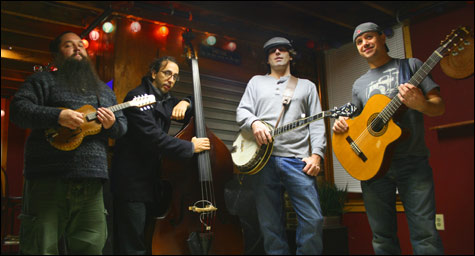
ZOOGRASS: Call them bluegrass, but Hot Day at the Zoo are also inspired by Nirvana, Bob Dylan, and reggae. |
Lowell is known for Kerouac, its historic canal system, and the Industrial Revolution, not the “high and lonesome” sound of bluegrass. But the music first minted in the Kentucky hills has a grip on the Spindle City, thanks to relative newcomers to the style Hot Day at the Zoo.
“We didn’t pick bluegrass; it picked us,” says the band’s mandolinist, a gregarious bear of a guy named David Cleaves. “I knew Mike [Dion], our guitarist and main songwriter, when I was living out in Seattle. He moved to the East Coast, and after a while I moved out here to Lowell to be close to my son, and Mike and I lived in the same house. Neither one of us had a job, so we thought we should write songs. And the instruments we had to write them on were the guitar and mandolin, so they sounded like bluegrass songs.”
Hot Day at the Zoo, who celebrate their fifth anniversary and the release of a new EP at Lizard Lounge this Saturday, came together with the addition of two banjoists and an upright-bassist whom Cleaves and Dion met at open mikes at Penuche’s Ale House, a jam-band hangout in Nashua, New Hampshire. “So with guitar, mandolin, upright, and banjo,” observes Cleaves, “we were suddenly a bluegrass band.”
The timing couldn’t have been better. Bluegrass has been catching the ears of increasingly roots-conscious high-school and college-age listeners since the turn of the millennium. But not necessarily in its pure form, which is packed with zippy virtuosic solos supporting vocalists warbling yarns of rural life and Jesus in high, arching nasal tones. A new generation of musicians — one raised with the influences of classic, alternative, and punk rock as well as new-school country music — has taken up the genre. Some, like 12-year-old guitarist Will Jones and his 16-year-old mandolinist sister Laura Leigh of Virginia’s Cana Ramblers, do come from the sticks. But the norm among new bluegrass bands is closer to the chemistry of King Wilkie, popular twentysomethings from suburban Charlottesville, Virginia, whose influences include the Byrds, Nico, Nick Drake, and Leonard Cohen as well as Bob Wills. For Hot Day at Zoo, the list of inspirations covers Nirvana, Bob Dylan, and reggae. Their live sound in particular favors an energy and sparseness closer to punk rock than to backwoods primitivism.
Hot Day at the Zoo and many other new-school bluegrass outfits are also finding their fans outside the regular circuit. “Our best audience is the jam scene,” says Cleaves. “We’ve heard, ‘That’s not the way bluegrass is supposed to be played,’ from some indignant older bluegrass fans who’ve heard us when we’ve opened shows for traditional bands. But, hey, we like what we do and our fans love it. The other guys in the band have started calling our music ‘zoograss.’ ”